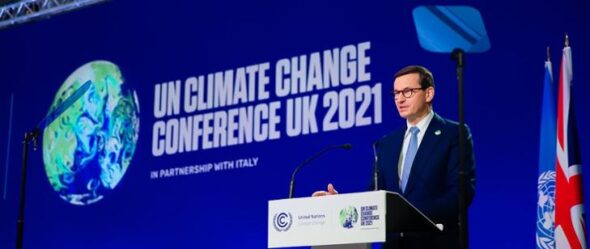At this year’s COP26 climate summit in Glasgow, China and the United States agreed to strengthen cooperation on climate policy. The two biggest CO2 emitters, which compete on many fronts, have in part found common ground and presented a joint plan. However, it included a point that the Chinese decided to reject – writes Jędrzej Stachura, editor at BiznesAlert.pl.
At the turn of October and November 2021, during the climate summit, there was a slight warming of relations between China and the United States. This happened behind the scenes, if we decide the proper scene is the technological war over 5G, semiconductors and a few others. Climate policy and the pursuit of the 2015 Paris Agreement have become an anchor point. At the time, 195 countries agreed that it was important to limit temperature increases to 1.5 degrees Celsius, but that it would require deep cuts in emissions and far-reaching changes in all aspects of social life. Limiting global temperature rise is to help humanity avoid the negative effects of climate change.
Six years ago, along with other signatories to the Paris agreement, China agreed to change its approach to climate policy. A year later, it became the biggest emitter of carbon dioxide and is now responsible for more than a quarter of the world’s total greenhouse gas emissions. China has strengthened its climate commitments in 2020, but according to the Climate Action Tracker, an international group of scientists, its current efforts to achieve this goal are insufficient. President Xi has said China would start phasing out coal in 2026 and will not invest in new coal projects abroad, but that may not be enough.
Scientists from the Tsinghua University in Beijing say that by 2050 the country will have to completely abandon the production of electricity from coal and replace it with nuclear and renewable energy. However, China’s actions show that it is far from closing coal-fired power plants, as it is currently building such facilities in more than 60 locations across the country. A new plant is usually active for 30 to 40 years, so China, if it is to reduce emissions, will have to reduce the capacity of the newer plants and perhaps close older ones.
Chance of success
This year’s climate summit was all about reducing methane emissions, switching to clean energy and decarbonisation. The United States and China played a leading role. Talks between the two coal powers, which together account for about 40 percent of global greenhouse gas emissions, could turn into a blame game and create a deadlock that would delay global supplies. However, the recent agreement between China and the United States has given hope for joint leadership. Something new emerged after Donald Trump’s presidency, which was full of firm decisions as well as controversial measures. In addition, the coronavirus pandemic and the climate crisis may not be the ideal time to cooperate with one’s biggest competitor, which is what China considers the US and vice versa. So, the new agreement could not have been ideal. Of course, envoys for climate from the US and China – John Kerry and Xie Zhenhua, exchanged warm words and assured that the Chinese and Americans had more in common than it seemed, but despite promises of cooperation to reduce methane emissions, the details of the plan are incomplete.
Climate Declaration
What exactly happened? In the final days of the climate summit, they presented the Joint Glasgow Declaration on Enhancing Climate Action in the 2020s. China and the US have agreed to work together to set up a „Working Group on Enhancing Climate Action in the 2020s” as soon as possible. The task force is to hold regular meetings and make decisions on climate policy and the fight against the crisis.
The document confirmed the previous, internal commitments of both countries, but it contains some new elements as well. The previously mentioned American-Chinese „Working Group on Enhancing Climate Action in the 2020s” and the desire to cooperate in reducing methane surprised the world, that is closely following the rivalry between the two powers.
The new-old component is the temperature limit of the Paris Agreement. Both sides recognised that keeping the temperature within the limits of the Agreement requires further action in the coming decade. Importantly, China has confirmed that it will make every effort to accelerate its plan to reach peak coal consumption by 2025.
Global Methane Pledge
Since relations between the Americans and the Chinese can not be too idyllic, the latter did not sign the methane agreement, signed by more than a hundred other countries. The Global Methane Pledge, as this document is called, commits to reducing methane emissions by 30 percent by 2030 in comparison to 2020 levels.
Among the countries that stayed outside the deal were also Russia and India, but only the Chinese gave something specific in return. They have ensured that they would approach this issue on a case-by-case basis and develop their own strong anti-pollution agenda. A month after the summit, China announced that it would look at ways to control and reduce methane emissions in various sectors, including coal, oil and waste. The Chinese plan is to launch a national strategy to control methane emissions and establish regulations to help reduce them. This is to encourage the cooperation of companies from the above sectors.
The Americans want to continue to talk about joint actions to reduce methane emissions and hope that the next talks with China will take place in the first half of 2022 and before COP27. So it seems that the United States is maintaining the course of its foreign policy towards China in other areas, but at the same time acknowledging that the two countries have a common interest in working to address the climate crisis.
This year’s meeting poured a little optimism into the hearts of observers of the constant rivalry between the US and China. From the point of view of the Americans it was by no means perfect, but still the Chinese showed willingness to participate in the fight against climate change. We should keep an eye on how this cooperation will develop and hope that it is not just Chinese propaganda that is behind the breakthrough COP26 and its promises.









